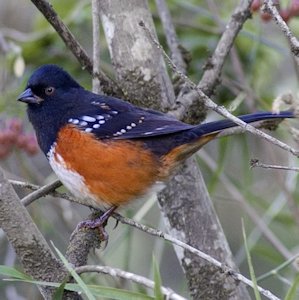
|
Birds Living in Safe Habitats The simplest and surest way for a bird to avoid being eaten is to live in an area where few predators live. For example, a duck might reduce its risk of becoming falcon food by living in the desert. The Gray Gull of Chile nests only in the extraordinary harsh Atacama Desert, well away from the coastal waters in which it feeds. The adults make long daily flights to bring food to the chicks and to share in the duties of keeping chicks warm at night and shaded during the day. The single advantage of this nesting site is safety from predators, none of which are willing to live in such an inhospitable location. Most birds, however, cannot abandon the habitats in which their food is found. Left: By placing its nest on the ground, this Rufous-sided Towhee can eliminate aerial predation but becomes vulnerable to ground predators. |
| Rufous-sided Towhee (Now known as Spotted Towhee) |